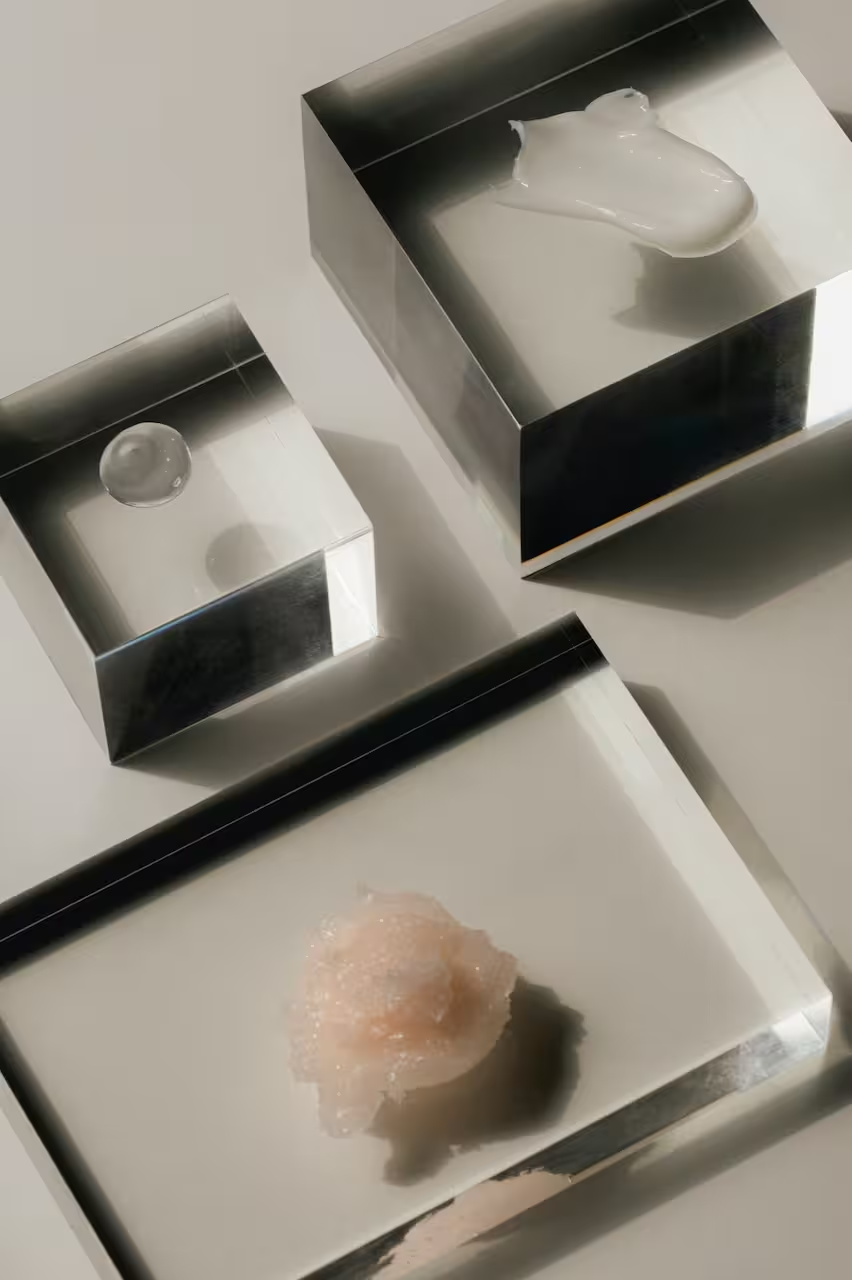

Does Boric Acid Help BV and Yeast Infections?
Learn how Evvy’s boric acid suppositories support vaginal health and when to use them.
Words by Olivia Cassano
Scientifically edited by Dr. Krystal Thomas-White, PhD
Medically reviewed by Dr. Christine Vo, MD
We’ve all hit the search engine when the standard treatment options for resistant, complicated, or frequent infections aren’t cutting it. While down your virtual rabbit hole, you might have come across boric acid for BV and yeast infections.
Maybe antibiotic treatment for bacterial vaginosis (BV) left you with a yeast infection in its place or, despite popping over-the-counter (OTC) antifungal suppositories like vaginal Tic Tacs, another yeast infection comes creeping in. So, can boric acid be the solution?
Boric acid is a compound that claims to treat vaginal infections. It's been used for centuries and research shows that it's safe for vaginal health. In recent years, it's started to make a comeback. That said, testimonials can be conflicting. While some say it knocked out their recurrent bacterial vaginosis or yeast infection when nothing else worked, others will warn of uncomfortable side effects and express safety concerns. In these cases, it’s hard to know what information is well-researched and science-backed.
That’s why we’ve broken down the ins and outs of boric acid for yeast and BV below.
What is boric acid?
Boric acid is a white powder composed of boron, oxygen, and hydrogen, and made from borax, a naturally occurring mineral.
When it’s used for vaginal infections, it comes in the form of powder or a capsule to insert vaginally as a suppository. It’s known to have antifungal and antiviral properties that emerging research suggests may help with recurrent vaginal infections.
Some folks use boric acid washes to help with issues like vaginal odor and itching. However, there's not a lot of solid research or regulation for these products, so it's hard to know for sure how well they work and how they deliver the medication.
FYI, generally, boric acid prescribed by a doctor (like the boric acid you can get through Evvy) tends to be purer and less likely to cause adverse reactions than boric acid purchased OTC or on Amazon.
Is it safe to put boric acid in your vagina?
Boric acid suppositories are generally safe when taken as prescribed or medically advised, especially in the short term.
Some people worry about boric acid's safety because it's linked to borax (sodium borate decahydrate), an ingredient commonly used in household cleaners. Even though they're made from the same compound, boric acid and borax are not the same thing.
Boric acid suppositories are only for inserting into your vagina. They should never be taken orally because they can be toxic if eaten in “extreme amounts” (15-20 g for adults and 5 g for infants).
However, boric acid vaginal suppositories are typically 600 mg and are generally considered safe if used as directed: inserted in the vagina, not consumed orally. To put it another way, an adult would need to consume 25 vaginal capsules at once to reach toxic levels.
Will boric acid help treat a yeast infection?
A yeast infection, aka vulvovaginal candidiasis, is a common vaginal infection caused by an overgrowth of yeast (a type of fungus), usually Candida albicans. Sometimes it’s caused by the more drug-resistant (and lesser-known) strain Candida glabrata.
The Centers for Disease Control and Prevention (CDC) guidelines recommend 600 mg of boric acid in a gelatin capsule administered vaginally once daily for three weeks for recurrent non-albicans vulvovaginal candidiasis. However, like many other instances in vaginal health, there needs to be more research on the effectiveness of boric acid on all types of Candida.
Speaking of atypical Candida strains, a 2007 study found boric acid suppositories solved 63.6% of Candida glabrata infections (a less common vaginal yeast species that can be resistant to OTC treatment, whereas Candida albicans causes most yeast infections).
By comparison, in the same study, fluconazole — commonly prescribed to treat vulvovaginal candidiasis — only resolved 28.6% of infections. Some research suggests antifungal resistance is a growing problem when treating yeast infections.
If your infections refuse to disappear or bounce back all the time, like a Marvel superhero, it may be worth talking to your doctor about vaginal boric acid. Overall, research suggests that boric acid may be as effective as or even more effective than traditional prescription antifungal medicines.
A 2018 review of multiple studies that looked at the use of boric acid, vaginally, specifically recommends boric acid treatment for antifungal-resistant infections. We’ll be keeping an eye on the FDA and CDC guidelines to see how they evolve based on this emerging research.
Do boric acid suppositories work for bacterial vaginosis?
Bacterial vaginosis is a term used to diagnose vaginal imbalances caused by the overgrowth of "bad" bacteria, such as Gardnerella vaginalis, Atopobium vaginae, and Prevotella bivia. Treating BV is a little more complicated overall, and it’s unclear if boric acid can treat bacterial vaginosis.
Sometimes, the first-line BV treatment (antibiotics) works but then sparks a yeast infection, meaning you’ve essentially swapped one vaginal infection for another.
Current treatment for symptomatic bacterial vaginosis includes antibiotics like metronidazole and the use of intravaginal boric acid. However, these treatments often have high recurrence rates and can lead to secondary candida infections.
Anecdotally, many people find that boric acid helps treat bacterial vaginosis symptoms. Surprisingly, there is not much research to back up boric acid as an effective treatment for bacterial vaginosis.
How Evvy’s boric acid suppositories support vaginal health during BV and yeast infections
Evvy’s Pure Boric Acid Suppositories are designed to support people dealing with recurrent or new vaginal symptoms like pH imbalance and odor.
These suppositories aren’t meant to treat the root cause of conditions like BV or yeast infections, but they can offer powerful symptom relief as part of a broader care plan. They're especially helpful for managing discomfort in between flare-ups, or when symptoms don’t fully go away.
Evvy’s Pure Boric Acid Suppositories work best when used alongside insights from your vaginal microbiome test and, if needed, one of Evvy’s Complete Treatment Programs. Together, they help you better understand what’s going on and find care that’s actually tailored to you, not just your symptoms.
While our Pure Boric Acid Suppositories require a prescription, you don’t need to make a doctor’s appointment to get them. Instead, they’re available online through Evvy after you take an Evvy Vaginal Health Test, which helps ensure they’re right for your unique vaginal microbiome.

Recurrent symptoms? Get Evvy's at-home vaginal microbiome test, designed by leading OB-GYNs.
Using boric acid after antibiotics
If you’ve recently completed antibiotic treatment for bacterial vaginosis but are still experiencing symptoms, or if the infection comes back shortly after treatment, you're not alone. Recurrent BV is common, and for some people, antibiotics alone may not completely resolve the imbalance in the vaginal microbiome.
Boric acid helps restore the vaginal pH to its normal acidic range and creates an environment that is less conducive to the overgrowth of harmful bacteria, such as Gardnerella vaginalis, which is a key contributor to bacterial vaginosis.
However, boric acid isn't a substitute for antibiotics and should only be used under the guidance of a healthcare provider. While it can be a helpful secondary treatment, it’s essential to ensure that bacterial vaginosis is the correct diagnosis and that there are no other underlying infections or health conditions. Your healthcare provider may recommend a specific treatment timeline, dosage, or follow-up plan based on your individual health history and symptom patterns.
Boric acid side effects
Vaginal boric acid first-timers can feel anxious about the potential side effects. But a 2011 review in the Journal of Women’s Health found that only 10% of participants, across multiple studies, reported boric acid side effects, from vaginal use.
A similar, but more recent review backed up these findings, concluding that (vaginally inserted) boric acid treatment was safe for most people.
The review also pointed out that there was barely any (if at all) absorption of boric acid into the bloodstream, over two weeks of using it vaginally.
However, there are currently no clinical studies examining the safety of long-term vaginal boric acid treatment, and, given how many people with vaginas use or consider using boric acid, the lack of research has “gender health gap” written all over it.
Common side effects of vaginal boric acid include:
- Vaginal irritation
- Vaginal itching
- A burning sensation in the vagina
- A gritty sensation in the vagina
- Watery vaginal discharge.
Can you use boric acid suppositories while pregnant?
Pregnant women would generally be advised against using intravaginal boric acid.
A healthcare provider may recommend boric acid suppositories for recurrent bacterial vaginosis when the individual experiences frequent infections.
The safety data available on vaginal use of boric acid can’t automatically be applied to pregnant people. For this group (and the developing embryo they carry), there isn’t enough data available to give it a thumbs up for safety, and it’s better to err on the side of caution here.
So, should I use boric acid suppositories?
For yeast infections, one study concluded that vaginal boric acid is at least just as effective as antifungals, if not better.
Research has shown that boric acid can be used to treat vaginal infections, including bacterial vaginosis, but it’s not FDA-approved for this use. Even without FDA approval, boric acid suppositories can still be prescribed by an OB-GYN, for vaginal use. Typically, it’s much better to use boric acid prescribed by a doctor because it tends to be purer and less likely to cause adverse reactions than boric acid purchased OTC. So let your OB-GYN guide you on this, especially if other treatments haven’t worked.
How do I know if boric acid is working as a treatment?
Taking an Evvy vaginal microbiome test before using boric acid (while you have symptoms) and after will help you understand if the treatment is actually helping your vaginal microbiome shift to a more protective state. An Evvy Membership unlocks our Compare feature, which allows you to view your microbes side by side, along with the products used at each test and your symptoms at that time.
Randomized controlled trials, including trial registration and placebo treatment arms, are crucial to validate the results of studies on boric acid. These trials ensure that the study design is robust and that the findings are reliable.
FAQ
Can boric acid treat BV and yeast?
Boric acid isn’t considered a first-line treatment for BV or yeast infections, but it can play a supportive role in certain cases. In the case of yeast infections, it may be used when the infection is caused by a non-albicans species of Candida, which are less responsive to typical antifungal treatments. While boric acid can help manage symptoms like pH imbalance and discharge, it doesn’t address the underlying causes of infection on its own. It’s important to talk to a healthcare provider or take a vaginal microbiome test, like Evvy’s, to understand whether boric acid is appropriate for your specific needs and to ensure that any underlying imbalances are properly identified and treated.
How often should you use boric acid suppositories?
Most boric acid suppositories are available in 600-milligram doses, which you insert once daily for one to two weeks. That said, a healthcare provider may recommend a different treatment plan based on your case. Although boric acid is considered safe, we’d advise against using it as a maintenance therapy for recurrent infections without speaking to your healthcare provider or OB-GYN first. You should never take boric acid orally because it’s extremely toxic when ingested. It can also be irritating for male partners, so it’s best to avoid receiving oral sex or having unprotected vaginal sex while using boric acid, and for a few days after finishing the treatment.
Can I get boric acid in the pharmacy?
Yes, you can find boric acid vaginal suppositories in most pharmacies and drugstores. It's available over the counter and is relatively inexpensive, ranging anywhere from $15-$30 on average. Although you can find “recipes” online to make your own at home, it’s better to purchase boric acid suppositories specifically formulated for vaginal health.
Have there been any deaths from boric acid suppositories?
If ingested, boric acid is toxic and can be potentially fatal. That said, it's unlikely that accidentally swallowing a vaginal boric acid suppository will kill you. According to the CDC, ingesting about 30 grams of boric acid is toxic to humans and could result in death. For reference, a boric acid suppository typically contains 600 milligrams. Using a suppository vaginally and as directed won’t cause death.
How many boric acid suppositories do you need for BV?
The number of boric acid suppositories needed to treat bacterial vaginosis depends on the treatment plan recommended by your healthcare provider, but common regimens involve using one 600 mg suppository inserted vaginally each day for seven to 30 days. For acute relief, some providers may suggest a seven to 10-day course, while others recommend extended use — up to 21 or 30 days — especially for recurrent BV. In some cases, boric acid is used after completing antibiotics as part of a longer-term maintenance strategy. It's important to follow your provider’s instructions and not exceed the recommended duration without medical supervision.
Does boric acid get rid of fishy smell?
Boric acid can help reduce vaginal odor, particularly when that odor is caused by an imbalance in the vaginal microbiome, such as in cases of BV. It's important to remember, though, that not all vaginal odors are a cause for concern. Some natural scent changes throughout your menstrual cycle are completely normal and don’t need any treatment. However, if you're experiencing a strong, fishy, or unpleasant smell, it might be a symptom of BV. While boric acid can support your vaginal pH and help reduce odor, it’s not normally the first treatment option for BV — antibiotics usually come first on that list. Using boric acid before getting a proper diagnosis might hide some symptoms or delay the right care, so it’s a great idea to talk to a healthcare provider before trying to treat vaginal odor on your own.
How fast does boric acid cure BV and yeast infections?
Boric acid doesn't "cure" BV or yeast infections, but when used to manage symptoms, many people start noticing symptom relief (like reduced odor or discharge) within a few days. That said, it’s typically used over seven to 14 days, depending on the recommendation from a healthcare provider. For recurrent BV, boric acid is often part of a longer-term maintenance routine after standard prescription treatments, rather than a standalone cure. In the case of yeast infections caused by non-albicans Candida species, boric acid may be used when typical antifungals don’t work, but again, it’s part of a broader care plan. If symptoms persist or keep coming back, it’s a good idea to explore deeper testing (like a vaginal microbiome test) to better understand what's driving the imbalance, and whether boric acid is the right tool for your situation.





